Book contents
- Mobile Technologies in the Ancient Sahara and Beyond
- The Trans-Saharan Archaeology Series
- Mobile Technologies in the Ancient Sahara and Beyond
- Copyright page
- Contents
- Figures
- Tables
- Contributors
- Preface
- Part I Introduction
- Part II Technological Mobility and Transfers
- Part III Metallurgy
- Part IV Glass Technology
- 10 Shattering Illusions
- 11 Glass Beads in African Society
- 12 Three Millennia of Egyptian Glassmaking
- Part V Handmade Pottery
- Part VI Conclusion
- Index
- References
10 - Shattering Illusions
Using Analytical Evidence to Establish Clearer Pictures of Glass Production and Trade within Africa
from Part IV - Glass Technology
Published online by Cambridge University Press: 18 September 2020
- Mobile Technologies in the Ancient Sahara and Beyond
- The Trans-Saharan Archaeology Series
- Mobile Technologies in the Ancient Sahara and Beyond
- Copyright page
- Contents
- Figures
- Tables
- Contributors
- Preface
- Part I Introduction
- Part II Technological Mobility and Transfers
- Part III Metallurgy
- Part IV Glass Technology
- 10 Shattering Illusions
- 11 Glass Beads in African Society
- 12 Three Millennia of Egyptian Glassmaking
- Part V Handmade Pottery
- Part VI Conclusion
- Index
- References
Summary
This chapter reports analysis of glass from the Garamantian heartlands in the central (Libyan) Sahara, including several fragments of imported Roman vessel glass. Results are contextualised within those of other published studies to develop a broader picture against which new analyses can be interpreted. The chapter aims to demonstrate the crucial importance of moving beyond a simple association between composition and provenance. Less archaeologically ‘visible’ practices such as recycling, which may take place periodically, in small installations, often leave subtle traces in the glass chemistry. The potential of data from trace element analyses in investigating these effects is explored. In addition, the possibilities of local African glass production, recycling and reworking are discussed.
Keywords
- Type
- Chapter
- Information
- Mobile Technologies in the Ancient Sahara and Beyond , pp. 317 - 384Publisher: Cambridge University PressPrint publication year: 2020
References
- 1
- Cited by



